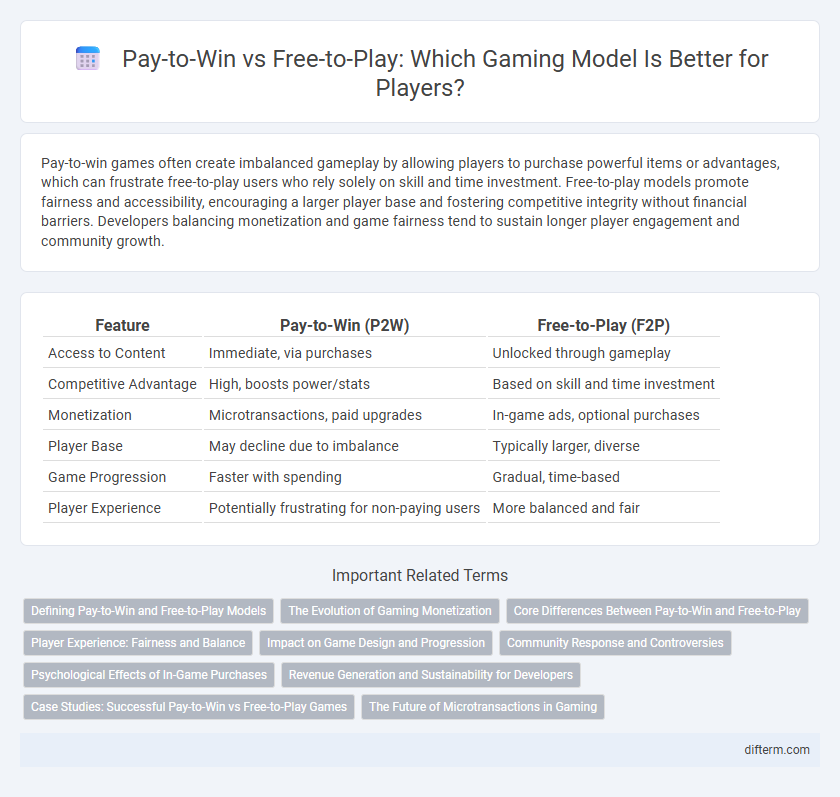Pay-to-win games often create imbalanced gameplay by allowing players to purchase powerful items or advantages, which can frustrate free-to-play users who rely solely on skill and time investment. Free-to-play models promote fairness and accessibility, encouraging a larger player base and fostering competitive integrity without financial barriers. Developers balancing monetization and game fairness tend to sustain longer player engagement and community growth.
Table of Comparison
| Feature | Pay-to-Win (P2W) | Free-to-Play (F2P) |
|---|---|---|
| Access to Content | Immediate, via purchases | Unlocked through gameplay |
| Competitive Advantage | High, boosts power/stats | Based on skill and time investment |
| Monetization | Microtransactions, paid upgrades | In-game ads, optional purchases |
| Player Base | May decline due to imbalance | Typically larger, diverse |
| Game Progression | Faster with spending | Gradual, time-based |
| Player Experience | Potentially frustrating for non-paying users | More balanced and fair |
Defining Pay-to-Win and Free-to-Play Models
Pay-to-win (P2W) gaming models allow players to purchase advantages that directly impact gameplay, such as stronger characters, exclusive items, or faster progression, creating an imbalance between paying and non-paying users. Free-to-play (F2P) games offer base access without cost, monetizing through optional in-game purchases, cosmetics, or expansions that do not necessarily affect competitive fairness. Understanding these models is crucial for analyzing player engagement, retention rates, and the overall economic strategies within the gaming industry.
The Evolution of Gaming Monetization
Gaming monetization has evolved from straightforward pay-to-win models, where players purchased direct advantages, to more complex free-to-play systems that emphasize in-game purchases and microtransactions. Free-to-play games rely heavily on virtual currencies, cosmetic items, and battle passes to generate revenue while maintaining player engagement without upfront costs. This shift reflects the industry's focus on balancing accessibility and profitability, driving innovation in player retention and monetization strategies.
Core Differences Between Pay-to-Win and Free-to-Play
Pay-to-win games often feature monetization models where players can purchase powerful items or advantages, effectively impacting competitive balance and progression speed. Free-to-play games provide access to all gameplay content without mandatory purchases, relying on cosmetic items or optional content for monetization. The core difference lies in whether spending money grants tangible in-game power that affects competitive fairness versus purely aesthetic or convenience enhancements.
Player Experience: Fairness and Balance
Pay-to-win mechanics disrupt player experience by creating imbalance, as players who spend money gain unfair advantages over skill-based progression. Free-to-play models prioritize fairness by allowing all players equal opportunities to succeed through gameplay rather than purchases. Maintaining game balance enhances player satisfaction and encourages competitive integrity.
Impact on Game Design and Progression
Pay-to-win mechanics often drive game design toward monetization strategies that prioritize power imbalances, encouraging players to purchase advantages that accelerate progression. Free-to-play models typically emphasize skill development and time investment, balancing progression systems to maintain player engagement without mandatory spending. This fundamental difference influences level design, reward distribution, and player retention strategies, shaping overall gameplay experiences in competitive and cooperative environments.
Community Response and Controversies
Pay-to-win models often trigger intense backlash from gaming communities, who criticize unfair advantages and diminished competitive integrity. Free-to-play games, while more inclusive, still face controversies over aggressive microtransactions and content gating. Community forums and social media platforms frequently debate these monetization strategies, influencing developers' approaches to game balance and player retention.
Psychological Effects of In-Game Purchases
In-game purchases in pay-to-win models often trigger psychological effects such as increased player frustration and reduced satisfaction due to perceived unfair advantages, leading to decreased long-term engagement. Free-to-play games utilize microtransactions to enhance cosmetics or convenience, maintaining player motivation without compromising competitive balance. These psychological dynamics influence player retention and spending behavior, affecting overall game profitability and community health.
Revenue Generation and Sustainability for Developers
Pay-to-win models generate higher immediate revenue through microtransactions, appealing to players willing to spend for competitive advantages. Free-to-play games rely on large player bases and monetize through cosmetic items and battle passes, fostering long-term engagement and sustainable income. Balancing monetization strategies is crucial for developers to maintain profitability while ensuring fair gameplay and player retention.
Case Studies: Successful Pay-to-Win vs Free-to-Play Games
Case studies reveal that pay-to-win games like Clash of Clans generate substantial revenue by encouraging microtransactions for faster progression, while free-to-play titles such as Fortnite thrive on cosmetic purchases that maintain competitive balance and player retention. Games like Candy Crush demonstrate how strategic pay-to-win elements can coexist with free-to-play mechanics to maximize user engagement and monetization. Successful free-to-play models prioritize fair gameplay and community building, whereas pay-to-win games rely heavily on monetization strategies that often affect game balance.
The Future of Microtransactions in Gaming
Microtransactions in gaming are evolving with increasing emphasis on balancing monetization and player experience to avoid pay-to-win mechanics that alienate free-to-play users. Innovative models like cosmetic-only purchases and battle passes offer revenue without compromising competitive fairness, ensuring long-term engagement. The future of microtransactions will likely see stricter regulations and player-driven demand for transparency, fostering healthier in-game economies and sustained game longevity.
pay-to-win vs free-to-play Infographic

 difterm.com
difterm.com